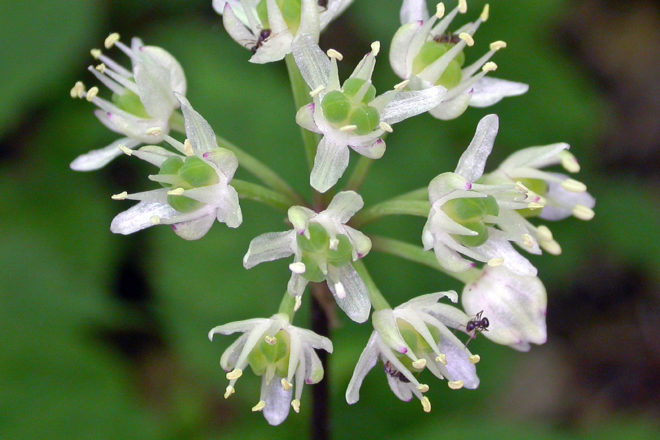Roy Lukes: Mysterious White Flowers
- Share
- Tweet
- Pin
- Share

Two native plants should be blooming in the upland hardwoods this month and many people will wonder what they are. A nine- to 10-inch tall stem with an umbel (a short wide cluster of flowers with stalks originating from the same spot) will decorate many woodlands but there are no leaves associated with the plant. It is the wild leek.
Many of you may be familiar with the leek, which is one of the first plants to bring greenery to the spring woods. The rolled up quill-like foliage of young plants in April quickly open into flat, rubbery, rich green leaves that can get to be two or more inches wide and eight to nine inches long. Frequently they will occur in patches of hundreds, or even thousands, of plants growing in rich soil of maple-beech hardwoods.
In case you are in doubt as to the plant’s identity, trust your nose for positive verification. There can be no mistake. Many people claim the odor and taste are a pleasant combination of onion and garlic. As the spring wanes all the leek leaves change to a yellow color, fade and then die. About a month later the flower spike arises and produces this mysterious blossom with no leaves.
Flowers are borne in the summer on a thin 9- or 10-inch tall stem. The quarter-inch greenish-white florets radiate from a central point and resemble a typical rounded cluster of onion flowers, although much smaller. By the fall the flowers give way to tiny steely blue-black buckshot-like seeds, each at the end of its half-inch long stem. Dig up the leek during fall color season and you will find the bulb to be the size of your thumb. Early in spring they are more like slender scallions.
Spring is the best time to eat the young tender leaves and small bulbs chopped finely and added to a tossed salad. My gentle warning is to go easy the first time. The plant is considered by health food advocates to be an excellent diuretic. Euell Gibbon’s book Stalking the Wild Asparagus lists several wild leek recipes for soup, salad, creamed leeks and even pickled leeks.

Two Indian pipe blossoms begin to show blackening while they mature with one already lifting its head up as the seeds ripen. Photo by Roy Lukes.
The other white mystery plant has no chlorophyll and in some instances will have a slight pinkish hue. It is the Indian pipe and is truly a flowering plant and not a fungus. People are surprised to learn that these “ghost pipes” belong to the blueberry family and are close relatives of the bearberry, wintergreen, trailing arbutus and cranberry.
I asked my wife last evening if she knew what plant family the Indian pipe belonged to, and I might have expected the answer she gave me, “Could it belong to the tobacco family?” she replied, jokingly.
It is difficult to imagine that a seed-producing flower can be colorless. A mass of brittle white fiber-like roots obtain this mystic plant’s food from interaction with fungi, such as Russula brevipes, the short-stalked Russula. The fungus mycelium works symbiotically with the roots of the American beech tree and transfers nutrients to the roots of the Indian pipe. A similar relationship helps other non-chlorophyll plants, like some wild orchids, to obtain their food.
The species name, uniflora, tells us it is a one-flowered plant. Each waxy clammy blossom grows from a scape, a naked flowering stem, arising from the ground.
What an exciting discovery to find these weird-looking oblong, bell-shaped blossoms nodding from four- to ten-inch stems. Frequently they grow in small dense clusters of 25 or more plants. We look for them in late July to early August among decayed leaves and evergreen needles in heavily shaded, moist, rich woods especially under pine, beech and oak trees. They can be found almost throughout temperate North America.
Each pallid, narrow cup-shaped blossom has four, five or occasionally six petals. The only leaves are mere scales or bracts, few in number, situated along the stem. They are extremely delicate, fine-toothed and paper-thin. Some plant scientists maintain that the leaves at one time were larger, contained chlorophyll and functioned as normal plant leaves do in the production of food for use by the plant.
As much as I shy away from anthropomorphism I can easily visualize the flower hanging its head shamefully, unable to make any of its own food, a branded sinner from the moment its seed was germinated and began to grow.
Slowly the blossom turns upward, as though it wanted to say something. Then is the time to peer into the opened “pipe bowl” to see that it really does have some color, the exquisite yellow stamens arranged in a neat circle around the edge of the round ovary.
Lacking chlorophyll it has been unable to make its own food as nearly all other seed plants do. Instead it had to depend upon other living or non-living plants for all of its nourishment. Finally it has lifted its head straight upward toward the sky as though proclaiming to all of its neighbors, “See, I can produce my own seeds!”
Frequently we find the stiff, black, upright remains of last year’s plants still persisting next to the ghostly huddle of new scapes.
Occasionally a few of the delicate waxy plants, backlighted by the early morning sun, will reveal a beautiful pink pearly translucence. How smooth! How fragile and pale they are! Rarely will your hikes through the woods reward you as wonderfully and surprisingly as when you discover these dainty little plants that surely possess virtuous charms, the Indian pipes, phantoms of the woods.




